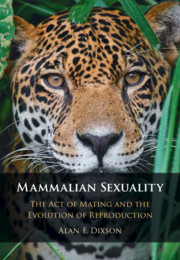Book contents
- Mammalian Sexuality
- Mammalian Sexuality
- Copyright page
- Dedication
- Contents
- Preface
- Acknowledgements
- Part I Carnival of the Animals
- Part II The Act of Mating
- 3 Copulatory Patterns: Phylogeny and Modes of Life
- 4 Copulatory Interactions and Sexual Selection
- Part III The Evolution of Reproduction
- Part IV Epilogue
- Book part
- References
- Index
4 - Copulatory Interactions and Sexual Selection
from Part II - The Act of Mating
Published online by Cambridge University Press: 20 May 2021
- Mammalian Sexuality
- Mammalian Sexuality
- Copyright page
- Dedication
- Contents
- Preface
- Acknowledgements
- Part I Carnival of the Animals
- Part II The Act of Mating
- 3 Copulatory Patterns: Phylogeny and Modes of Life
- 4 Copulatory Interactions and Sexual Selection
- Part III The Evolution of Reproduction
- Part IV Epilogue
- Book part
- References
- Index
Summary
The last chapter considered the act of mating primarily from the perspective of male mammals, and discussed the effects of phylogeny and modes of life upon masculine patterns of copulatory behaviour. By contrast, this chapter addresses the interplay between the sexes that occurs during copulation. In many mammals, females mate with multiple partners during the fertile period. Under these conditions, the stage is set for sexual selection, via cryptic female choice, as well as sperm competition, to influence the fate of gametes that are deposited in the female reproductive tract by rival males. Thus, in what follows, the behaviour and physiological responses of both sexes will be discussed in relation to events that take place during and after copulation. Figure 4.1 shows, in diagrammatic form, relationships between sperm competition and cryptic female choice. On the left-hand side of the diagram, sperm from several males are depicted as ‘competitors in a race’, as they vie to to gain access to an ovum. The female’s reproductive tract is a ‘level playing field’ in which this contest takes place. The right-hand side of the diagram introduces a note of reality into this androcentric vision. Sperm do not have direct access to ova; the vagina, cervix, uterus, uterotubal junction and oviduct all present challenges to the survival and onward progression of spermatozoa. The female’s reproductive anatomy and physiology play crucial roles in transporting sperm, and also in controlling the temporary storage of gametes. Thus, although vast numbers of spermatozoa are released at ejaculation, few of them ever gain proximity to an ovum.
- Type
- Chapter
- Information
- Mammalian SexualityThe Act of Mating and the Evolution of Reproduction, pp. 89 - 108Publisher: Cambridge University PressPrint publication year: 2021



